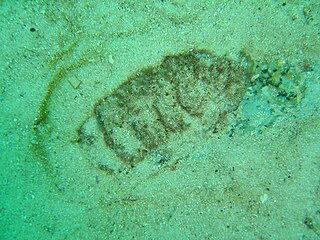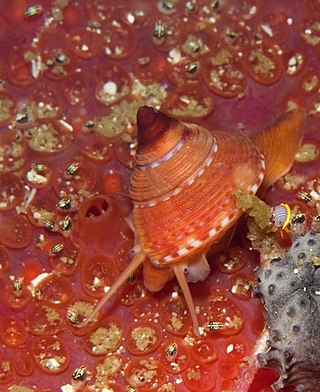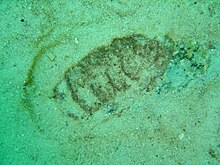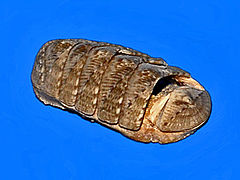
Chiton tuberculatus, the West Indian green chiton, is a species of chiton, a marine polyplacophoran mollusk in the family Chitonidae, the typical chitons.

The hunchback amphipod, Iphimedia gibba, is a species of amphipod crustacean. It is a marine arthropod in the family Iphimediidae. It was first described in 1955 by Keppel Harcourt Barnard as Cypsiphimedia gibba.

The hairy chiton is a species of chiton in the family Chaetopleuridae. It is a marine mollusc.
Chaetopleura pertusa, the orange hairy chiton, is a species of chitons in the family Chaetopleuridae. It is a marine mollusc. It is endemic to South Africa.

Dinoplax is a genus of chitons in the family Chaetopleuridae. They are marine molluscs.

Burnupena papyracea, common name the papery burnupena, is a species of sea snail, a marine gastropod mollusk in the family Buccinidae, the true whelks.

Calliostoma ornatum, common name the ornate topshell, is a species of sea snail, a marine gastropod mollusk in the family Calliostomatidae.

Aulacomya atra, called also the Magellan mussel or the ribbed mussel, is a southern species of edible saltwater mussel, a marine bivalve mollusk in the family Mytilidae, the true mussels. Note that the common name ribbed mussel is also used of the Northern Hemisphere mussel Geukensia demissa.

Plaxiphora albida, the white Plaxiphora chiton, is a species of chiton in the family Mopaliidae.
Ischnochiton oniscus, the dwarf chiton, is a small polyplacophoran mollusc in the family Ischnochitonidae, endemic to the coast of southern Africa.
Ischnochiton bergoti, the ribbed-scale chiton, is a small polyplacophoran mollusc in the family Ischnochitonidae, endemic to the west coast of southern Africa.
Chiton salihafui, the python chiton, is a medium-sized polyplacophoran mollusc in the family Chitonidae, found on the west coast of Africa.

Chiton politus, the tulip chiton, is a medium-sized polyplacophoran mollusc in the family Chitonidae, found on the coast of southern Africa.

Radsia nigrovirescens, the brooding chiton, is a small polyplacophoran mollusc in the family Chitonidae, found on the west coast of southern Africa.

Callochiton dentatus, the broad chiton, is a medium to large-sized polyplacophoran mollusc in the family Callochitonidae, found on the coast of southern Africa.

Acanthochitona garnoti, the spiny chiton, is a medium-sized polyplacophoran mollusc in the family Acanthochitonidae, found on the coast of southern Africa.

Onithochiton literatus, the black chiton, is a medium to large-sized polyplacophoran mollusc in the family Chitonidae, found on the east coast of Africa.

Dinoplax validifossus, the Natal giant chiton, is a large polyplacophoran mollusc in the family Chaetopleuridae, found on the western coast of southern Africa. It was originally considered a subspecies of the giant chiton.

The Marine biodiversity of South Africa is the variety of living organisms that live in the seas off the coast of South Africa. It includes genetic, species and ecosystems biodiversity in a range of habitats spread over a range of ecologically varied regions, influenced by the geomorphology of the seabed and circulation of major and local water masses, which distribute both living organisms and nutrients in complex and time-variable patterns.
















